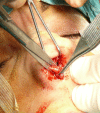Semi-open rhinoplasty: a new maxillofacial technique
- PMID: 22546278
- PMCID: PMC3411475
- DOI: 10.1186/1746-160X-8-13
Semi-open rhinoplasty: a new maxillofacial technique
Abstract
Background: Rhinoplasty "open" represents a surgical technique to access to the internal structures of the nose; it is an alternative to more traditional "closed" rhinoplasty. However, both these techniques have some advantages and some disadvantages. In this work the authors describe a case that shows the steps of a new surgical technique: the "semi-open" rhinoplasty.
Methods: The "semi-open" technique is performed by making an incision to access on the mucosa of both the nostrils, and through this access we separate the cartilages of the columella from the alar cartilages, debriding them at the domus. With such access we can perform any type of rhinoplasty surgery with functional or aesthetic purposes.
Discussions: Traditional techniques have undoubtedly some advantages and some disadvantages. The "semi-open" technique has the several advantages of the open technique, and it does not involve the presence of post-surgical scars.
Conclusions: This innovative technique provides great predictability and minimal postoperative discomfort, with no aesthetic damage.
Figures













References
-
- DeFatta RJ, Ducic Y, Adelson RT, Sabatini PR. Comparison of closed reduction alone versus primary open repair of acute nasoseptal fractures. J Otolaryngol Head Neck Surg. 2008;37(4):502–506. - PubMed
-
- Inchingolo F, Tatullo M, Marrelli M, Inchingolo AM, Picciariello V, Inchingolo AD, Dipalma G, Vermesan D, Cagiano R. Clinical trial with bromelain in third molar exodontia. Eur Rev Med Pharmacol Sci. 2010;14(9):771–774. - PubMed
MeSH terms
LinkOut - more resources
Full Text Sources

